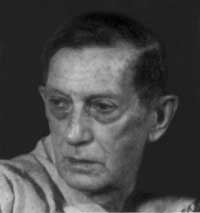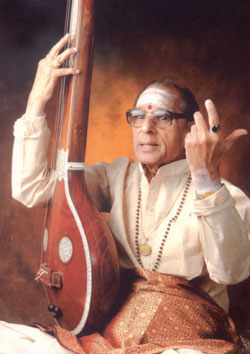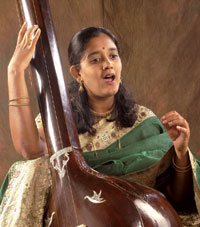NEWS & NOTES

Opera … of love and destiny -ILEANA CITARISTI
On the occasion of Alain Danielou’s centenary celebrations which culminated in October 2007, the Alain Danielou Foundation, with branches in Rome, Berlin and Paris, presented a series of concerts and exhibitions in different Italian cities related to the life and work of the great musicologist and scholar. One of the major events of the series was the presentation of seven songs by Rabindranath Tagore translated into Western musical notations for voice and piano by Danielou, at Tagore’s request. Danielou was a great friend and admirer of Tagore.
The performance, conceived as an opera for voice, dance, music and recitation with the participation of Ileana Citaristi, dancer and choreographer, Saswat Joshi, Odissi dancer, Surendra Maharana, percussionist, Francesca Cassio, dhrupad singer, Ugo Bonessi, pianist and composer and Claudio Di Palma, stage actor, and with direction by Nadia Baldi, was staged in Zagarolo, the village adopted by Danielou as his Italian retreat, in Rome (Teatro Palladium), and Bergamo (Teatro Donizzetti) on the 13th, 14th of October and 1st of November 2007 respectively.
COVER STORY

Old is gold, so what’s new? - V. RAMNARAYAN
Bigger… and better?” we asked in our last issue on the Chennai music and dance season. Bigger it certainly has been but whether better is arguable. We shall at any rate wait till our next issue, when all our correspondents will have filed their stories, before we pass judgement. Yes, it’s early days yet but on evidence gathered so far, some eminent representatives of an earlier era of music gave greater demonstrations of the grandeur and depth of Carnatic music than today’s stars. Devotion rather than showmanship prevailed in these concerts, leaving even newcomers to kutcheri listening thirsting for more.
Nedunuri Krishnamurti at the Music Academy, for instance, belied his 79 summers, with his stirring effort to bring out the soul of the sangeetam of which he has been a worshipful devotee. True there was the occasional slip owing largely to a voice rendered recalcitrant no doubt by age and the December throat, but the striving for perfection and the dedication to bhava were unmistakable. In the best guru-sishya tradition, the Malladi Brothers gave the septuagenarian devout support. The accompanists Sriram Parasuram, Tiruchi Sankaran and T.V. Vasan combined in a seamless partnership to give a delightful start to the season at the Academy. Fittingly, the foursome received a standing ovation.
An equally moving experience was listening to Tanjavur Sankara Iyer at a Naada Inbam concert at Raga Sudha hall. For the handful of listeners present at the kutcheri, it was an unforgettable Sunday morning, as Sankara Iyer fought a sore throat and frail health to reach out towards some deeply personal musical goal. He found time to chat with the audience as well as his two disciples on the stage, coaxing them to sing full throatedly, but in vain, as the sishya-s in their reverence for their guru, refused to raise their voices. Umayalpuram Mali’s resonant percussion support too was appropriately subdued in keeping with the general air of bhakti towards the veteran. Violinist Varadarajan was restraint personified until under constant prodding by the vocalist he surpassed himself with some exquisite bowing, producing music that can only be described as profound. It was a clear demonstration of what complete absorption in the music submerging the self in a spirit of devotion by a seasoned artist can do. It is to Varadarajan’s credit that his performance that morning was compared for its ripe classicism with a magnificent offering by T.N. Krishnan in November at the same venue during the R.K. Venkatarama Sastry centenary week.
SPECIAL FEATURE

Rhadha - The dancing heart Part 2 -SUJATHA VIJAYARAGHAVAN
Rhadha, senior Bharatanatyam exponent and guru, was honoured by Sri Krishna Gana Sabha with the title Acharya Choodamani on 5th December 2007 on the inaugural day of the 52nd Art and Dance Festival in Chennai. This is the concluding part of the article; the first part was published in Sruti 279.
Rhadha now had an excellent team of disciples. I prepared the script and music in consultation with Rhadha and was the main singer for all the projects. My mother Ananthalakshmi Sadagopan composed the music for a number of songs, including most of the songs in the dance-drama Vallee Bharatam. T.K. Padmanabhan, enthusiastic associate in composing the instrumental score, composed an exquisite tillana in Sree raga for Meenakshi Ammai Pillai Tamil, presented first at the conference of the Tamil Isai Sangam. Soundara Kailasam, the Tamil poet, told Rhadha that she had brought goddess Meenakshi on stage in all her splendour and divinity.
Between 1987 and 1999 Rhadha produced twenty dance-dramas and thematic presentations on widely varied topics (see box). Some memorable ones were Bhavaye Padmanabham, Jaya Jaya Gokula Bala, Desh and Buddha Deva. There were repeat performances of most of the dance-dramas and Rhadha was invited by the Music Academy to present Nauka Charitram and Vallee Bharatam.
MAIN FEATURE

Manjiri Asnare-Kelkar
A modern interpreter of an orthodox idiom - DEEPAK S. RAJA
With the categoric steering of Jaipur-Atrauli vocalism towards romanticism by Kishori Amonkar, only an accidental modernisation could have given its orthodox idiom a fresh lease of life. Though her musicianship has yet to deliver its promise, Manjiri Asnare-Kelkar (born: 1971) could just be the accident the Jaipur legacy needed. Manjiri’s music maintains a substantial stylistic distance from the last orthodox stalwart, Dhondutai Kulkarni, as well as the revisionist exponent, Kishori Amonkar. And, yet there is no mistaking the orthodox Jaipur flavour in her music.
Manjiri was selected by the Sangeet Natak Akademi for the first Bismillah Khan Memorial Award for Young Musicians in early 2007. A few years earlier, India Today, the influential news magazine, had hailed hers as the “voice that spans not merely two octaves, but two centuries”. In less than a decade, she has established a significant presence on the Indian concert platform, acquired a following abroad, and released five commercial recordings. She became a broadcaster on All India Radio at the age of 16, after topping its nationwide talent-search, and currently occupies the penultimate "A" grade. She holds post-graduate degrees in English Literature as well as Music.
Coming to terms with a musician’s risks
Manjiri spoke to the author on June 3, 2003
"My family is deeply involved with music. My grandfather was an advocate in Amravati (a town in north-eastern Maharashtra), and an excellent tabla player. He studied with the best percussionists in Amravati, and belonged to the Gyan Prakash Ghosh lineage. The family home was never without music and musicians. Because of my grandfather’s love for music, my father also got involved. He trained as a tabla player and, in his youth, stood first in the All India Radio national talent search competition."


